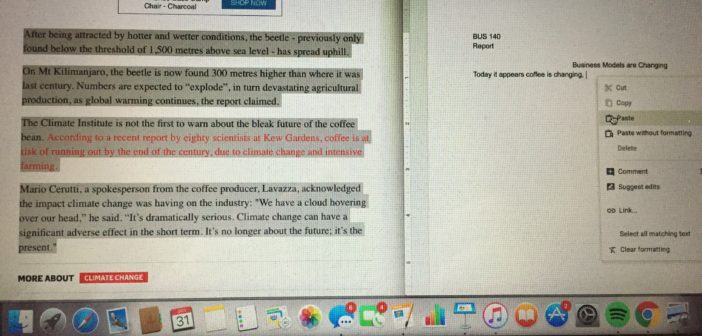Plagiarism, the act of using someone else’s work or ideas as your own, is not a new concept. However, discouraging plagiarism has increased in the last few years, along with stricter punishments for offenders and efforts to educate students about the topic.
An article published by the Pew Research Institute in 2013 found that nearly 90 percent of advanced placement and national writing project teachers spent time in class discussing plagiarism and source citing. Addressing and educating students about plagiarism and how to avoid it is an accepted practice among teachers.
Assistant Professor of English Ashley Ott said that putting a section on plagiarism in the course syllabus was a requirement from the school. She explained that it was important to create assignments that would breed original thinking and to lay the groundwork in entry-level classes on how to correctly cite sources.
Ott said that plagiarism may be becoming more frequent due to the change in the circulation and accessibility of information. She discussed that “from the printing press to the internet, the climate in which information spreads has changed dramatically.”
Students in today’s college classrooms have access to information on nearly every topic, and the temptation to simply express these ideas as their own may be what is causing the higher rates of plagiarism. A 2011 study from the Pew Research Institute found that 55 percent of college presidents reported an increase in plagiarism in the last 10 years. Eighty-nine percent of these same presidents also stated that they believed computers and the internet played a major role in this increase.
The standard plagiarism policies in college usually include failure of the course for first-time offenders and expulsion for repeat offenders. Ott said that this punishment seems appropriate, but that it could depend on many factors such as the “severity of the offense, the student in question, and the nature of the school.”
She explained that making decisions regarding expulsion on a college campus is a “huge drain of resources” for the administration. Decisions regarding expulsion are usually lengthy and involve many faculty members. Plagiarizers also reflect poorly on a university, which is why some prestigious schools may have more strict policies than others.
Liam Haeffele, ’20, said that he has never been in a situation where he felt plagiarism was necessary or appropriate. He felt that students may benefit from an initial warning for a first-time offense, and “use the warning as a learning experience.”
Haeffele also said that with teachers’ radars for plagiarism so high and the automatic plagiarism checks on Blackboard, there was no way he could get away with it.
Nic Mann, a junior at Northeastern Illinois University, has different views on plagiarism. On a few occasions, he was tempted to plagiarize but “the benefits never outweighed the risk,” so he used his own work despite the stress and time crunch it put him in.
Mann also said that the college tuition in America is too expensive to be kicking people out of school so quickly, forcing them to pay even more to make up the missing credits. Mann explained that at his school he believed he might be able to get away with minor plagiarism like using another student’s work, but not work copied from a website or textbook.

